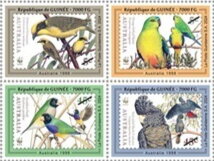Se-tenant: Australia - Birds (Guinea 2024)
Australia - Birds (Guinea 2024)
07 March (Guinea ) within release Fauna of the World on Stamps (2024) goes into circulation Se-tenant Australia - Birds face value 4*7000 Guinean franc
| Se-tenant Australia - Birds in catalogues | |
|---|---|
| Colnect codes: | Col: GN 2024.03.07-292 |
Se-tenant is square format.
Issued in both full panes of four se-tenant blocks and mini-sheets of two se-tenant blocks.Also in the issue Fauna of the World on Stamps (2024):
- Mini Sheet - Aitutaki - Blue Lorikeet (Vini peruviana) face value 8*7000;
- Full Pane - Aitutaki - Blue Lorikeet (Vini peruviana) face value 16*7000;
- Se-tenant - Aitutaki - Blue Lorikeet (Vini peruviana) face value 4*7000;
- Mini Sheet - Argentina Pampas Deer/Vicugna//Southern Pudu/Chacoan Peccary face value 8*7000;
- Full Pane - Argentina Pampas Deer/Vicugna//Southern Pudu/Chacoan Peccary face value 16*7000;
- Se-tenant - Argentina Pampas Deer/Vicugna//Southern Pudu/Chacoan Peccary face value 4*7000;
- Mini Sheet - Armenia - Bezoar Ibex (Capra aegagrus aegagrus) face value 8*7000;
- Full Pane - Armenia - Bezoar Ibex (Capra aegagrus aegagrus) face value 16*7000;
- Se-tenant - Armenia - Bezoar Ibex (Capra aegagrus aegagrus) face value 4*7000;
- Mini Sheet - Australia - Birds face value 8*7000;
- Full Pane - Australia - Birds face value 16*7000;
- Se-tenant - Australia - Birds face value 4*7000;
- Mini Sheet - Australian Antarctic - Leopard Seal (Hydrurga leptonyx) face value 8*7000;
- Full Pane - Australian Antarctic - Leopard Seal (Hydrurga leptonyx) face value 16*7000;
- Se-tenant - Australian Antarctic - Leopard Seal (Hydrurga leptonyx) face value 4*7000;
Se-tenant Australia - Birds it reflects the thematic directions:
Animals are multicellular, eukaryotic organisms of the kingdom Animalia (also called Metazoa). All animals are motile, meaning they can move spontaneously and independently, at some point in their lives. Their body plan eventually becomes fixed as they develop, although some undergo a process of metamorphosis later on in their lives. All animals are heterotrophs: they must ingest other organisms or their products for sustenance.
Birds (Aves), a subgroup of Reptiles, are the last living examples of Dinosaurs. They are a group of endothermic vertebrates, characterised by feathers, toothless beaked jaws, the laying of hard-shelled eggs, a high metabolic rate, a four-chambered heart, and a strong yet lightweight skeleton. Birds live worldwide and range in size from the 5 cm (2 in) bee hummingbird to the 2.75 m (9 ft) ostrich. They rank as the class of tetrapods with the most living species, at approximately ten thousand, with more than half of these being passerines, sometimes known as perching birds. Birds are the closest living relatives of crocodilians.
Parrots (Psittaciformes), also known as psittacines (/ˈsɪtəsaɪnz/), are birds with a strong curved beak, upright stance, and clawed feet. They are classified in four families that contain roughly 410 species in 101 genera, found mostly in tropical and subtropical regions. The four families are the Psittaculidae (Old World parrots), Psittacidae (African and New World parrots), Cacatuoidea (cockatoos), and Strigopidae (New Zealand parrots). One-third of all parrot species are threatened by extinction, with a higher aggregate extinction risk (IUCN Red List Index) than any other comparable bird group Parrots have a generally pantropical distribution with several species inhabiting temperate regions as well. The greatest diversity of parrots is in South America and Australasia



